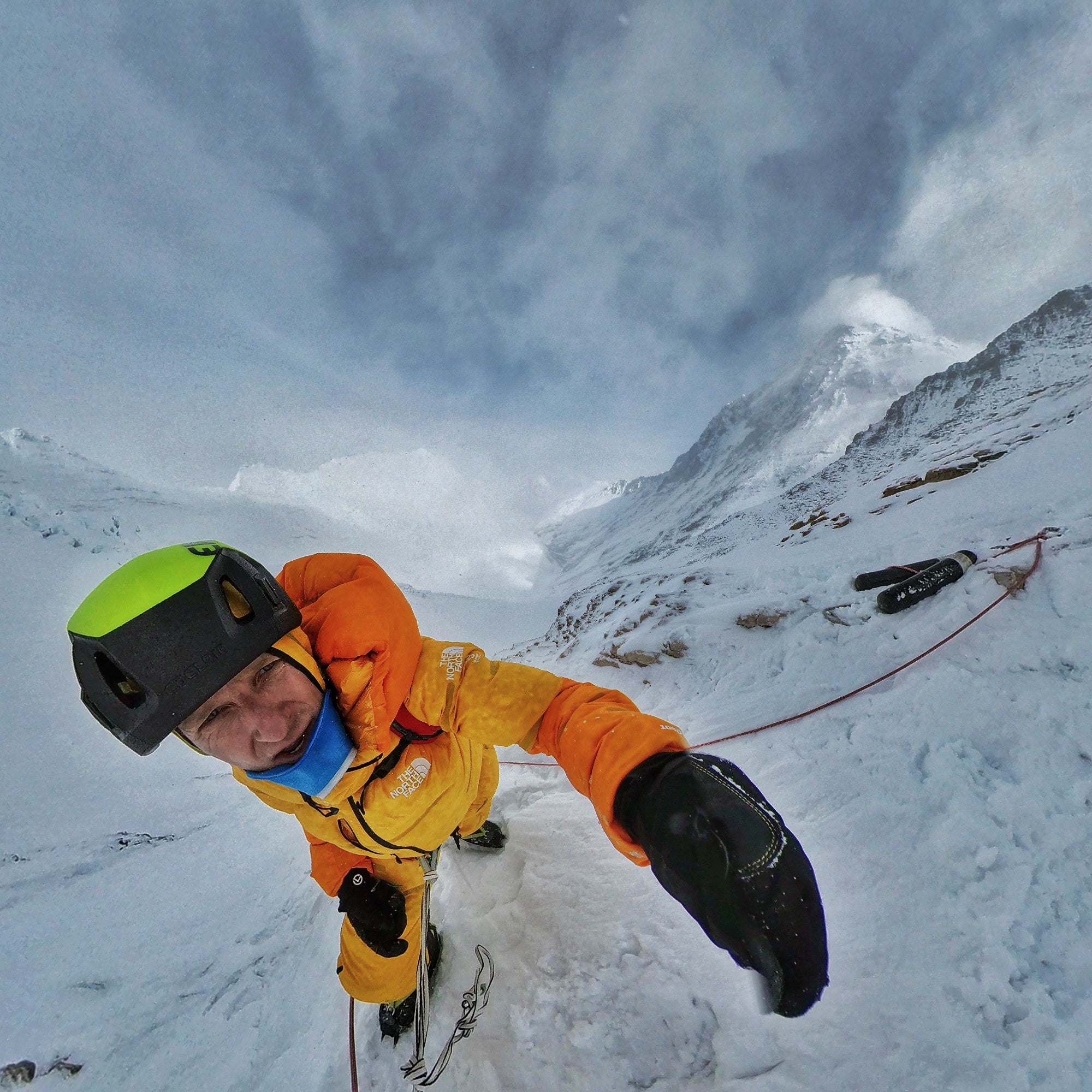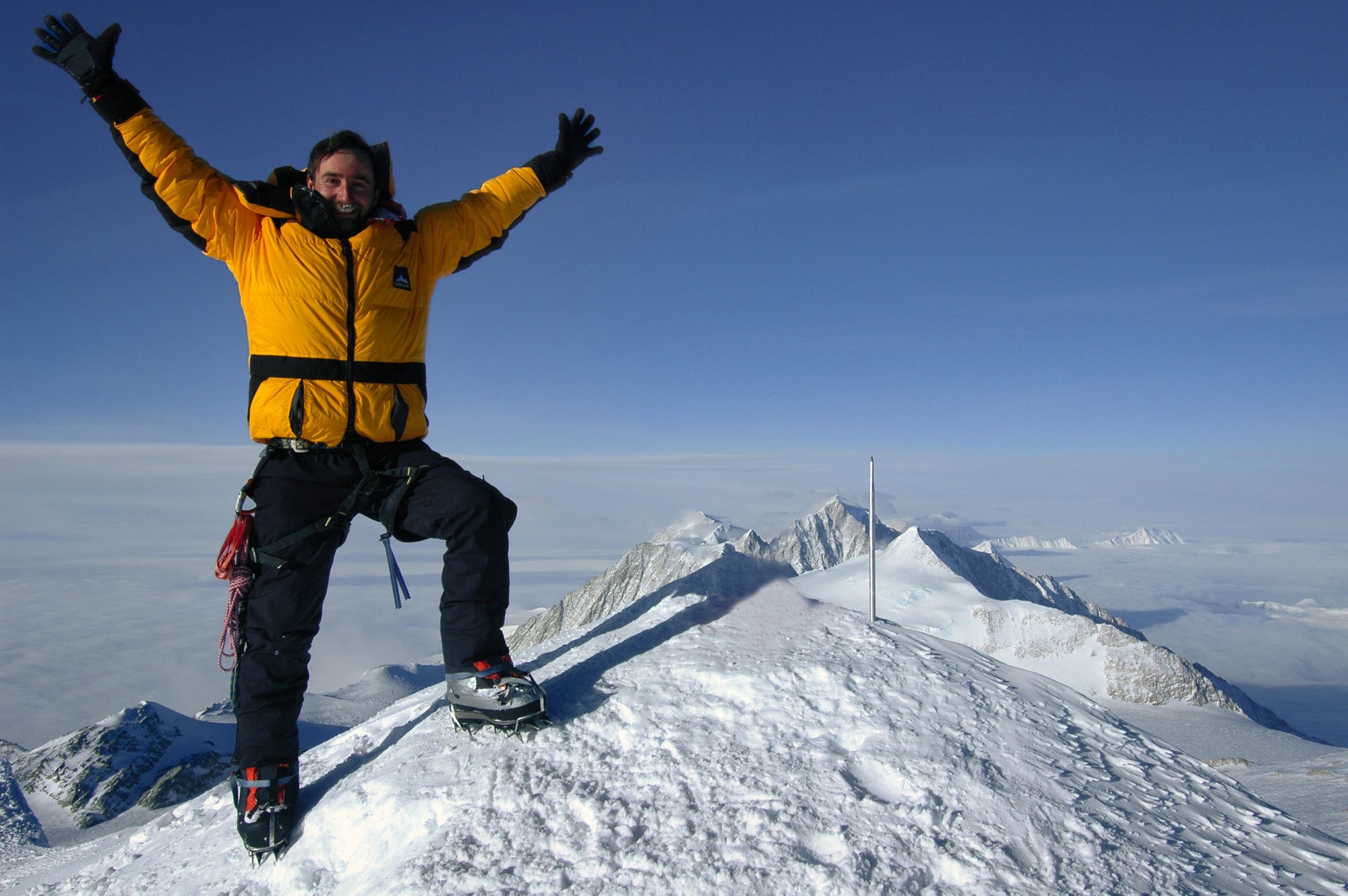Julia: Hello Christian! It's great that you're here with us today. To start, why don't you introduce yourself briefly?
My name is Christian Stangl, I was born in Upper Styria and have lived here in Admont for 25 years. Initially, I was an ordinary electrical engineer in Austria and Lybia. At the age of 35 I had finally had enough of it and decided to only climb mountains for a year - because I had always liked doing it. I then somehow "fell" into the professional mountaineering scene and was sponsored by various companies as a professional mountaineer for 14 years. Today I am a mountain guide and offer a wide variety of mountaineering and climbing courses.
Julia: When did you start mountaineering?
I pretty much started when I was 2 years old. Mountaineering used to be "our weekend activity" as a family, but for me as a kid it was often not that interesting. At the age of 14 I started mountaineering and climbing on my own. I did that in my free time up until I was 35 years old, when I decided to travel the world and climb mountains full-time.
Julia: How important are adventures in your life?
Adventures have always been exciting and super interesting for me. Nowadays mountaineering has generally become less adventurous, since many tours are already planned down to the last detail. For example, one of my greatest adventures was crossing the Atacama high desert in South America. When I left, I knew that I would only be walking in one direction for a month and couldn't plan anything in advance. No one had ever done that before and it was a real adventure for me. The road is at 5,000 hm and although it is a desert, it also snows there. That way I always had drinking water.
Before I started this adventure, I had no idea what to expect. In the first few days, I sometimes asked myself if I should turn back - but at some point you're so immersed in the adventure that the fear disappears and you let yourself go. For me, this uncertainty is what makes a real adventure.
Julia: Have you had more adventures like this?
Yes, I started a first ascent in the Andes in March 2018, that was the south ridge of Sierra du Mara. There I climbed a 6,800 meter high mountain that had never been climbed before. Every meter is a secret and every thought you have revolves around the adventure ahead. I also like that I am 100% responsible for myself during this time. It's dangerous to know that any help would be too late in an emergency, but that's what makes it exciting for me: to do something outside of social security. I am completely free in what I do.
Julia: What kind of thoughts encourage you before such an adventure if you don't know how it will end?
On this first ascent in 2018, I felt strengthened because I was the first person to do it. And that gives me full motivation and the most fun. At that time I was traveling alone for 10 days and didn't come across any human traces.
Julia: I've heard in another interview that the silence that surrounds you can get pretty loud in some situations. How do you feel about this?
My conclusion from these 10 days or my 34 days alone in the high desert is that I do get along with myself very well. It's always a weird feeling for the first few days - just having no contact with the outside world. You have to go through the weaning phase at first, but after that I've always enjoyed it. Even though I was completely alone, I still had good days and bad days. And it's exciting that you can't project your own mood onto someone else. That was a month of free silent monastery - other people pay a lot of money for this experience (laughs).
Julia: Today, of course, I want to talk to you about your greatest adventure: climbing the Triple Seven Summits, i.e. climbing the three highest mountains on all continents. Can you tell us more about that?
Yes, that was my biggest project so far and it took me 7 years. I have received several awards for this and I am still the only person to achieve this. No one will be able to imitate me anytime soon, especially because of Corona and political events.

Julia: How did you come up with the idea - was that your plan from the start or did it somehow develop over time?
It developed like this. I actually started my career with "skyrunning", that's what I called it. I just wanted to climb the highest mountains on earth as quickly as possible, in one go, without any intermediate camp. I was an athlete with very high standards.
Note: Christian holds speed records on Aconcagua (4h25), Elbrus (5h18) and Mountain Vinson (9h10).
However, I have noticed that very good athletes are coming and taking my records away from me. So I started climbing the 7 highest summits on earth. I found out that the second highest mountains in the world had not yet been climbed by one person and I wanted to start right away. However, it wasn't always clear which mountain was the second highest. That's why I then decided to climb the third highest mountains straight away.
And so I also somehow became a scientist, because I measured some mountains professionally. The University of Graz was also involved, they provided me with a differential GPS to determine the exact height of the mountains. In the end I climbed a total of 29 mountains instead of the actual 21 mountains - just to be really sure. Only since I measured these mountains (2013), the ranking has finally been corrected as to which mountain is the highest, second highest and third highest mountain. It seems actually crazy to me that we lived in the 21st century and that nobody knew.
At the third highest mountain in Oceania, I was the 8th person in history to climb it. In order to climb this mountain I really had to come up with a lot. The first time I tried, the police and military stopped me and sent me back home. They even accompanied me to the plane personally. So I had to come up with something. The next time I pretended to be a butterfly collector so I wouldn't have to fly home again. That's what my principle back then was: don't wake sleeping dogs! Because if you really want to do it, you shouldn't ask too many questions or attract attention.

What was very exciting about this trip in Oceania was the many tribes that I encountered. I needed two translators to understand Indonesian, English and the language of the peoples. Once we came across one of the dying peoples in a cave and I sent one of the translators to ask them what they were doing here. It wasn't that warm there and they were just completely naked. But my translator just couldn't understand them because he didn't understand their language. There are such deep gorges within the country that the different peoples have never mixed nor a collective language has emerged. At the time, I was really fascinated by how resistant these peoples are. They walk around without any clothes or shoes at 3,000 meters above sea level. Once a little boy, not older than 10 years, accompanied us for days on our mountain tour - without shoes! He even slept in the rain and ate things in the forest.
Julia: Would you say that the political hurdles were the biggest obstacles, or was there anything else you hadn't thought of?
Yes, the fundraising (laughs). In the beginning, I was an optimist and thought to myself "that'll work somehow". And I think you have to be, because if you try to plan everything right at the beginning of a big adventure, then you will ALWAYS realize that it is theoretically not possible.
For example, when I climbed the first Seven Summits, I finally had to go to Antarctica. However, I didn't know how to get to Antarctica or where to get 20,000-30,000 euros quickly. But somehow the sponsors were always there. All in all I was in Antarctica 4x, so you can calculate how much money I've left there.

Julia: Which moments will you always remember from your adventure?
This is difficult question. What fascinated me about the project were the different mountaineering conditions on the different continents. I had to face ice in Antarctica and then again jungle in Oceania - but that's what made it exciting. In the Antarctic you always have to make sure that you don't run out of fuel in order to melt the deep-frozen ice and be able to drink - on the contrary, in Papua it was pouring rain and I had to make sure that at least my sleeping bag stayed dry.
Julia: How do you prepare for something like that? Who do you ask for help?
Lots of self-awareness, you can get general information, but never the details. A lot went wrong on my first trip to Papua and on my second trip I brought rubber boots from Bellaflora (note: a gardening shop) with me (laughs). I also learned the hard way that even cheese containing some water freezes rock solid in Antarctica. But the more you go there, the more you learn.
Julia: Did you always make it up to the summit the first time, or did you have to try several times to reach the peak?
Sometimes it worked the first time and sometimes we had to go up to 5 times.
Julia: Which 3 tips would you give to other adventurers?
#1 Just do it!
If you think about life for too long, then you're suddenly too old for it. You can't plan everything anyway. At my last summit of the Triple Seven Summits, for example, I simply cycled from my home in Admont to the Caucasus. I was out and about for 38 days with my bike and my mountaineering gear, I then climbed the mountain and rode my bike back home afterwards. I ended up doing a bike tour by the Black Sea, you don't do things like these every day.

#2 the journey is the destination
If I had always planned everything, I wouldn't have finished at all, so I just started without thinking too much. The amazing thing about such adventures is that the journey is just as exciting as the mountain itself.
#3 be open to new cultures
Make your own experiences with foreign cultures and don't believe everything you hear or read from others.
You can find more about Christian Stangl here: www.bergfuehrer-stangl.com




